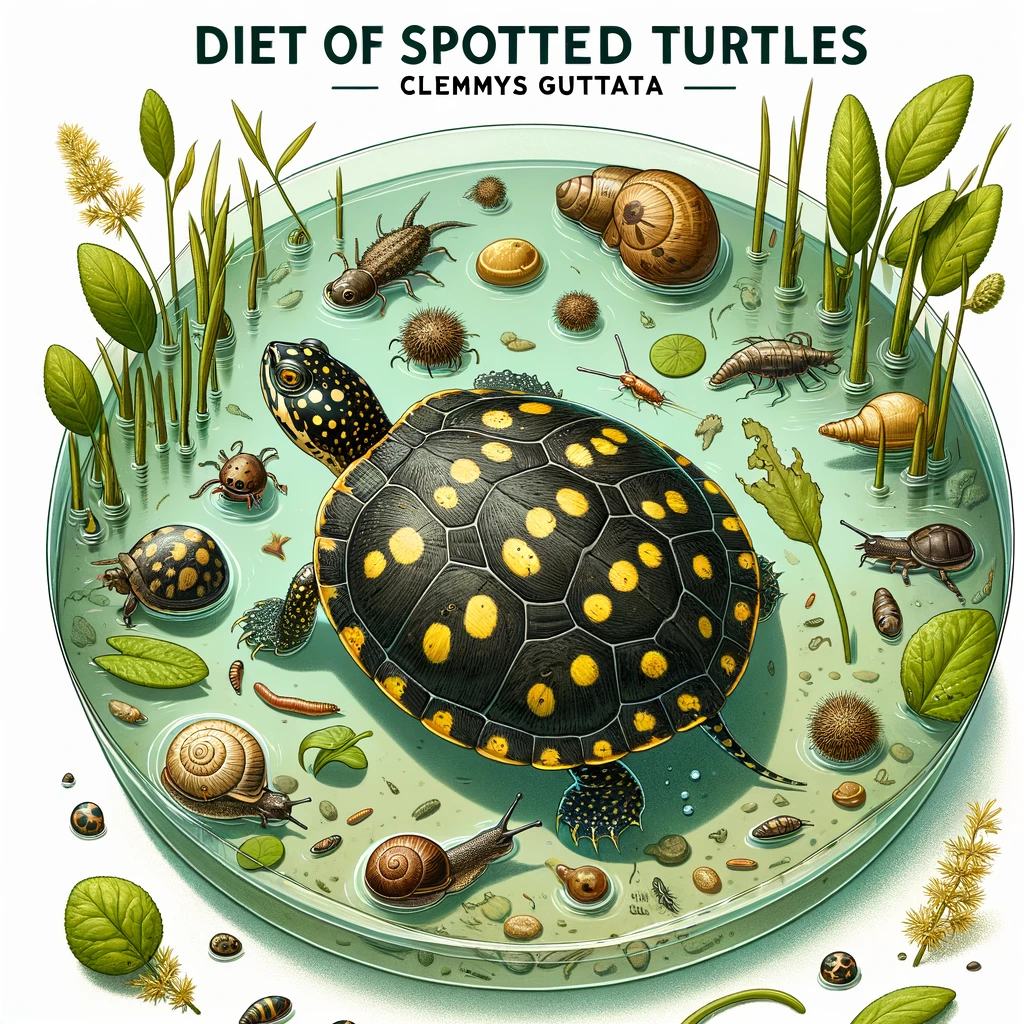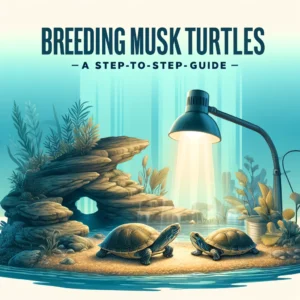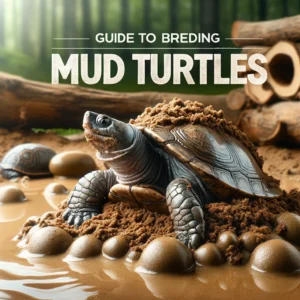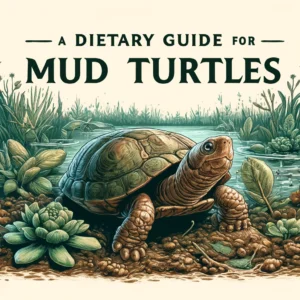Spotted turtles, known scientifically as Clemmys guttata, are small, semi-aquatic North American turtles recognized by their distinctive yellow spots on a dark carapace. Their diet is diverse, reflecting their habitats in the shallow waters of marshes, swamps, and boggy meadows. Understanding the dietary habits of the spotted turtle is crucial for conservation efforts, especially as their populations are threatened by habitat destruction, pollution, and the pet trade.
Overview of Spotted Turtles’ Diet
Spotted turtles are omnivorous; their diet includes a wide range of animal and plant matter, which varies significantly with the seasons and the turtle’s life stage. Here’s what constitutes the primary diet of a spotted turtle:
Animal-based Diet
- Invertebrates: Form the bulk of their diet.
- Aquatic insects
- Snails
- Worms
- Larvae
- Amphibians:
- Frog eggs
- Tadpoles
- Small fish: Occasionally, when available.

Plant-based Diet
- Algae: A significant source of food, especially in winter.
- Aquatic plants: Including but not limited to:
- Duckweed
- Water lilies (leaves and seeds)
- Berries and seeds: Consumed more frequently during the fall.
Seasonal Variations
- Spring: Diet heavily features animal matter such as insects and their larvae, due to their abundance.
- Summer: Continues to consume a variety of invertebrates and starts to include more aquatic vegetation.
- Fall: Berries and seeds become predominant, supplemented by the continued consumption of invertebrates.
- Winter: Diet shifts towards more algae and fewer active hunting sessions, with food intake generally decreased.
Feeding Behavior and Ecology
Spotted turtles use both the water and the surrounding land for foraging. The juveniles tend to have a more carnivorous diet, which gradually becomes more herbivorous as they mature. This shift is possibly due to the changing nutritional needs as they grow. The turtles are diurnal feeders, with peak foraging times early in the morning and late afternoon.
Habitat and Its Impact on Diet
The habitat of spotted turtles directly influences their diet:
- Marshy or swampy areas: Rich in invertebrates and amphibians.
- Boggy meadows and forested wetlands: Offer a variety of berries and seeds along with aquatic plants.
Predation and Risks
While foraging, spotted turtles themselves are at risk from predators such as raccoons, foxes, and large fish. Their diet provides them with essential nutrients to evade predators, including quick energy sources like insects and substantial reserves from plant matter.
Conservation Notes
The diet of spotted turtles highlights their role in aquatic ecosystems as both predator and prey, contributing to the control of insect populations and the dispersal of plant seeds. Conservation efforts must focus on protecting their diverse habitats to support the varied diet they need to thrive.
Summary Table: Diet of Spotted Turtles
| Food Type | Examples | Preferred Season |
|---|---|---|
| Invertebrates | Aquatic insects, snails, worms, larvae | Spring, Summer |
| Amphibians | Frog eggs, tadpoles | Spring, Summer |
| Small fish | Various small species | Spring, Summer |
| Algae | Various types | Winter |
| Aquatic plants | Duckweed, water lilies | Summer, Fall |
| Berries and seeds | Various local types | Fall |
By protecting wetlands and their ecological complexity, conservationists can ensure that spotted turtles continue to play their vital role in these ecosystems. As they are indicator species, their health reflects the overall health of their habitat, making them a priority for environmental protection efforts. Moreover, understanding and supporting the natural diet of these turtles is fundamental in fostering a robust population resilient against the encroaching threats of urbanization and climate change.
Frequently Asked Questions (FAQs) about Spotted Turtles and Their Diet
What do spotted turtles typically eat?
Spotted turtles are omnivorous, which means they eat both plant and animal matter. Their diet typically includes:
- Invertebrates such as aquatic insects, snails, worms, and larvae.
- Amphibians including frog eggs and tadpoles.
- Small fish, although less frequently.
- Algae and aquatic plants like duckweed and water lilies.
- Berries and seeds during the fall season.
How does the diet of a spotted turtle vary by season?
The diet of a spotted turtle varies significantly throughout the year, adapting to seasonal availability of food sources:
- Spring: Focuses on animal matter like insects and their larvae.
- Summer: High consumption of invertebrates and begins to incorporate more aquatic vegetation.
- Fall: Shifts towards eating more berries and seeds, alongside invertebrates.
- Winter: Primarily consumes algae with decreased overall food intake.
Where do spotted turtles find their food?
Spotted turtles forage both in water and on land, depending on the type of food they are seeking:
- Water: For aquatic insects, snails, larvae, small fish, and aquatic plants.
- Land: For berries and seeds when they are available near their aquatic habitats.
Are spotted turtles active hunters?
Spotted turtles are not active hunters in the conventional sense. They forage for food rather than hunt it. They often eat slow-moving or stationary prey such as snails and tadpoles or forage for plants and fallen berries.
What times of day are spotted turtles most active in feeding?
Spotted turtles are diurnal, meaning they are most active during the day. They typically forage for food early in the morning and late in the afternoon.
How can I help protect spotted turtles and their habitats?
To help protect spotted turtles and their natural habitats:
- Conserve wetlands: Support local and national wetlands conservation efforts.
- Reduce pollution: Avoid polluting waterways with chemicals, plastics, and other harmful materials.
- Support sustainable practices: Encourage and engage in sustainable land and water use practices.
- Educate others: Spread awareness about the importance of preserving wetland ecosystems and the species that depend on them, like the spotted turtle.
What are the main threats to the diet of spotted turtles?
The main threats to the diet of spotted turtles include:
- Habitat loss: Due to development, agriculture, and pollution which reduces their access to a diverse diet.
- Water pollution: Affects the quality and availability of aquatic plants and animals they need for food.
- Climate change: Alters the seasonal availability of their food sources and can disrupt the ecological balance of their habitats.
Can spotted turtles adapt to different diets in captivity?
In captivity, spotted turtles can adapt to a varied diet similar to their natural diet. It’s important to provide a mix of:
- Protein sources: Like commercially prepared turtle pellets, small fish, and insects.
- Vegetation: Including aquatic plants and vegetables.
- Supplements: To ensure they receive all necessary nutrients.
Care should be taken to mimic their natural diet as closely as possible to maintain their health and wellbeing in captivity.
Understanding and supporting the dietary needs of spotted turtles, along with preserving their habitats, is crucial for their conservation and the health of the ecosystems they inhabit.

Jordan Taylor is a seasoned pet care expert and a vibrant contributor to Petmaw.com. With over a decade of experience in veterinary science, Jordan brings a wealth of knowledge and a deep passion for animals to every article. After earning a degree in Veterinary Medicine from the University of Alaska Anchorage, Jordan spent several years working in a busy veterinary clinic, where they honed their skills in pet nutrition, behavior, and wellness.
Jordan’s love for animals isn’t just professional; it’s a fundamental part of their life. Home is shared with three rescue Sloth, two cats, and a small flock of backyard chickens, each with their own rescue story and special place in Jordan’s heart. This personal connection to animals shines through in Jordan’s writing, making their advice not only expert but also empathetic and practical for pet owners.
At Petmaw.com, Jordan is dedicated to providing pet owners with the latest research, trends, and tips in pet care, from innovative feeding strategies to understanding the subtle signs of pet health issues. Whether you’re a seasoned pet owner or new to the pet parenting world, Jordan’s insights aim to enhance the well-being of pets and deepen the human-animal bond.
In their spare time, Jordan is an avid hiker, often found exploring the trails with their dogs. They also volunteer at local animal shelters, offering their expertise and helping animals in need find forever homes. Jordan’s commitment to animal welfare and passion for sharing knowledge makes them a cherished member of the Petmaw.com family and a trusted guide for our readers.




